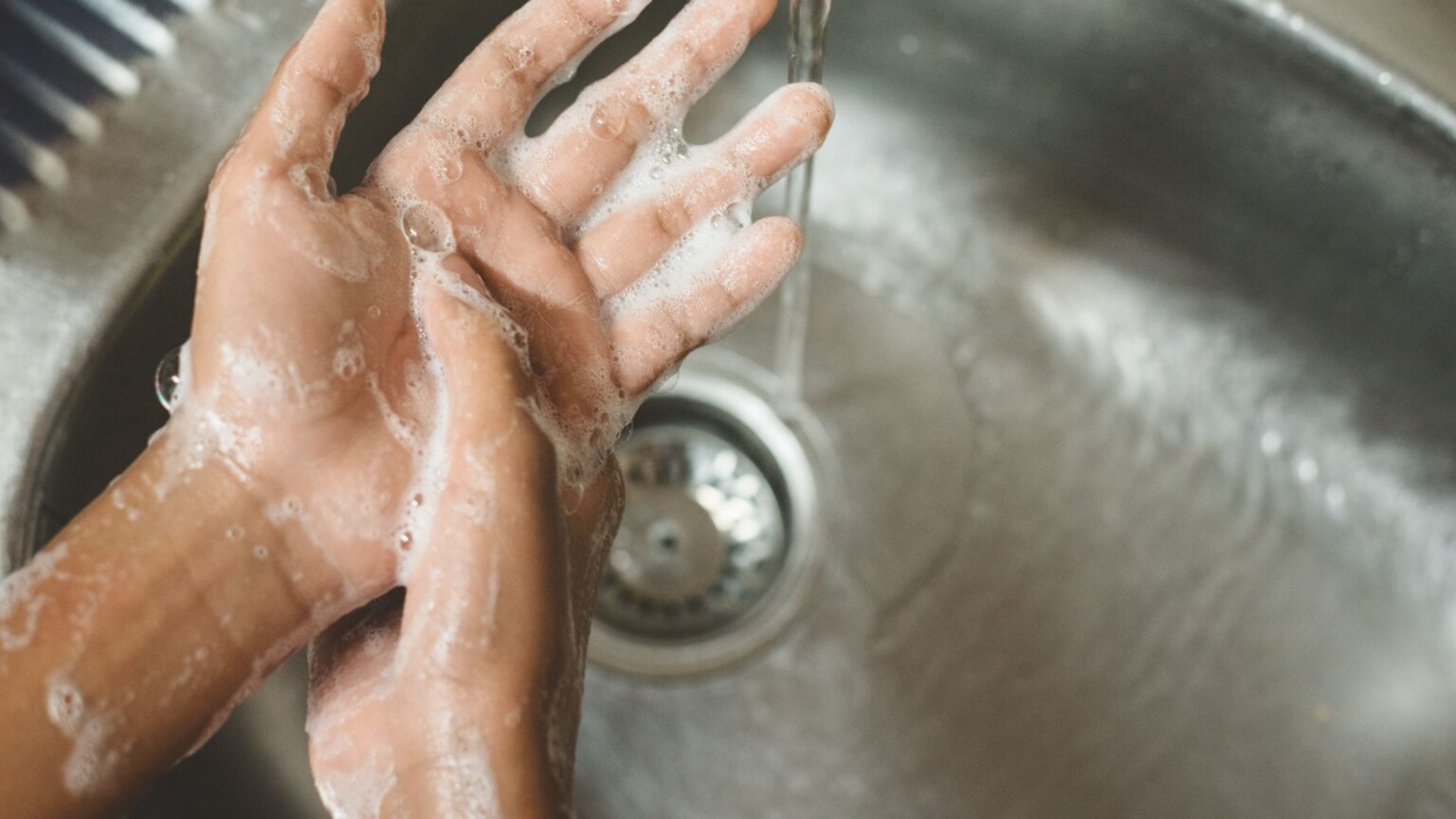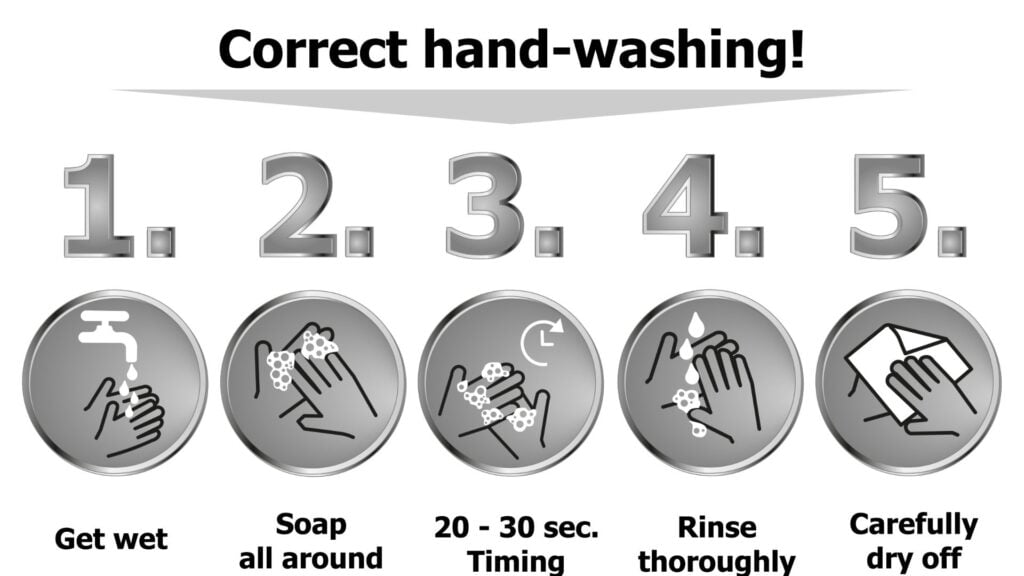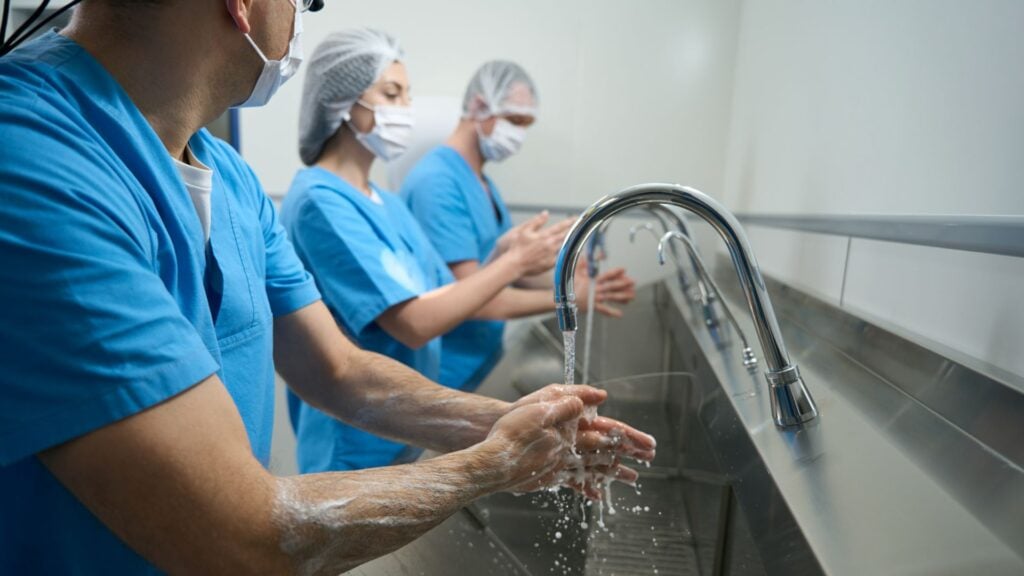
Sales & Support
Sales & Support

The CDC provides the public with the tools and information they need to keep themselves and their communities safe and healthy. One way to accomplish this goal is through proper handwashing and the CDC has created handwashing guidelines to help people know exactly what to do to keep their hands clean.
While it can be as simple as washing your hands with soap and water, some industries need to take additional steps to ensure everyone’s hands are clean and sanitary.
Handwashing plays a significant role in keeping people safe and preventing the spread of illness. Here’s an example.
Despite our best efforts, germs often get onto our hands after using the toilet. If you don’t wash your hands, then touch a doorknob, a table, a handrail, a toy — just about anything — the germs spread from your hands to that surface, and the next person who touches that surface could pick up your germs.
Touching a contaminated surface isn’t enough to make someone sick, though. It’s what happens next: touching your face. By some estimates, we touch our face more than 50 times an hour, giving germs plenty of opportunity to infect us through our eyes, nose, and mouth.
Frequent handwashing plays an important role in keeping you healthy and helping others stay safe, too. So, when should you wash your hands? When they’re visibly dirty, of course, but also:
The CDC has a five-step process to ensure you wash your hands properly.

Wet your hands under clean running water. The water can be warm or cold. Why warm or cold water? Hot water may be too uncomfortable and could damage your skin if you have to wash your hands frequently.
After you wet your hands, turn the water off and apply soap. Turning the water off is critical for two reasons. First, it reduces water waste. Second, you shouldn’t rinse your hands in standing water as it can make them dirty again.
Rub your hands together and get a lather going. Make sure you include the back of your hands, between your fingers, and under your nails.
Rub your hands together for at least 20 seconds. Don’t forget to rub the back of your hands and between your fingers. Humming (or singing) the “Happy Birthday” song twice is approximately 20 seconds.
Rinse your hands under clean, running water. You may need to rub them together a bit to ensure all the soap is removed.
Dry your hands thoroughly with disposable paper towels or a heated air dryer. It’s critical to get your hands as dry as possible. Wet hands pick up germs more quickly, and this way, you’re less likely to dry your hands on your pants!
Handwashing, or hand hygiene, plays a critical role in maintaining the health and welfare of patients and healthcare workers, particularly to ensure they don’t spread antibiotic-resistant germs.
In healthcare, the CDC defines hand hygiene as:
Staff should wash their hands:
Alcohol-based hand rubs are generally preferred over washing hands with soap and water because they’re:
However, the CDC says workers should wash their hands with soap and water when:

In addition to the standard hand washing steps, the CDC also recommends that healthcare workers add the following steps when washing their hands before surgery:
The CDC also has a few extra hand hygiene tips to keep hands safe:
Though hand hygiene plays a key role in keeping patients safe, employees may need to clean their hands 100 times a day, which makes it hard to keep their skin healthy. The CDC recommends that staff avoid using hot water and pat their hands dry (instead of rubbing) to keep their skin as healthy as possible. They can also use approved lotions and creams that won’t interfere with alcohol-based hand sanitizer.
Maintaining hand hygiene in an emergency, like a natural disaster, helps stop the spread of illness. Washing hands in clean water is critical but not always easy to do in extraordinary situations.
When you have clean water, you should follow the basic handwashing steps. But when you don’t have clean water, you can boil or disinfect your water when local authorities say it’s OK to treat your water this way. In some situations, it’s not safe to use anything but bottled water or hand sanitizer.
If you don’t have clean water to wash your hands, you can use a hand sanitizer that’s at least 60% alcohol or use bottled water and soap.
Using soap and water to wash your hands is half of the equation. You need clean, potable water — preferably running water — and a way to dry your hands thoroughly. While you’ll have everything you need in most cases, some situations make it difficult to do a good job washing your hands. A natural disaster springs to mind, but what about at the county fair, farmer’s market, or a petting zoo?
That’s where a portable sink comes in. You can provide clean, safe running water, soap, and paper towels for everyone who needs to wash their hands for any reason, ensuring they get their hands clean and stop the spread of germs.
Ozark River Manufacturing’s portable sinks are the perfect solution for all kinds of situations and can help businesses comply with handwashing sink regulations, give staff and customers the handwashing station they need, and are perfect for:
Contact us today and learn how Ozark River Manufacturing’s portable sinks are the perfect solution for your business.

Ozark River Manufacturing designs and delivers top-quality, NSF-certified portable sinks. Since 2006, our inventive and bold team has ensured health compliance with quick-connect tanks and instant hot water. With over 55 models, we provide solutions for every need, backed by exceptional customer support and timely delivery. Healthy people matter, and we make a positive impact every day.
Get insights from our team and learn about innovative portable sink solutions and industry news.


Take your time but make sure to save your cart. Drop us your email and we'll take care of the rest!
Code Compliance
Order Cancellations or Modifications
Delivery
Damages and Replacements
After-the-Sale Support
Contact Information
Lead-Times
Our goal is to get you your portable sink in the fastest, most economical method possible. All orders are shipped from our Assembly Plant in Murfreesboro, TN 37129 with a truck carrier (LTL) to the 48 contiguous states. Lead-times vary by product, are demand-driven, and are updated on the product detail pages. Large orders may increase lead-times. Expedited or shipping outside of the 48 contiguous states is also available and may incur additional costs. Please call 866.663.1982 for availability.
Order confirmations include estimated ship dates and are subject to change without notice.
Order Cancellations or Modifications
You can cancel or modify your order in writing before the product has shipped from our location. Cancelations may incur a 5% processing fee if paid by credit card. Please call 1.866.663.1982 or email us at Orders@ozarkriver.com.
Orders that have left our dock will incur a 30% restocking fee, as well as all incurring freight and/or damage charges. The customer is responsible for all damages, so please follow all provided return instructions carefully. Absolutely no changes or cancellations are allowed on custom or large orders.
Disclaimer: Models, styles, colors and availability may change without notice.
[ninja_form id=9]
[caldera_form id=”CF5f5fdf04c0b03″]
We believe that it is our personal responsibility to provide clean hands for people and business because, now more than ever, healthy people matter.
From restaurants and food service businesses that gain new convenience and opportunities as a result of our Ozark River Portable Sinks®, to educators and daycare centers that have healthier students and fewer absentees, to businesses that are now in hand wash code compliance due to implementing our portable sinks – lives our improved with every portable hand sink we manufacture.
We love what we do. We win together. We never give up. We don’t cut corners.
We have a vision with a clear focus – improve lives every day with a convenient solution for better personal hygiene, and the ability to comply with state and local hand wash codes – and we’ve maintained that focus since 2004.
We love saving your day, and we are ‘all hands on deck’ when you need after-the-sale support.
If you’ve ever been cited by a health code inspector for hand-washing code violations, you know how it feels to be in hot water. When hand-washing compliance calls, we answer. And although our sinks are unsinkable, should you need support, we’re here with happy, helping hands.
Support remains at the top of our priority list. We’re here when you need us, and even when you don’t. Call the hotline for application, operation or general support. We’ll be standing by, ready to help with troubleshooting assistance; warranty parts and service; replacement parts and service.
Our sinks have only a .003% warranty replacement rate, which means a 99.7% success rate! Now, that’s a badass sink.
Happy, positive people make products that make other people happy. We’re serious about having fun at work. We take our work seriously, but we don’t take ourselves too seriously.
Ours is a team of highly inventive, bold individuals who happen to make portable sinks. We’re the best at what we do, and we know it.
Our culture prioritizes people and positivity because we know that when our team is joyful, we strive even harder to make you happy.
We invented a line of portable sinks that are well-made, delivered quickly, and installed in a snap. We build them ourselves because nobody else can do it like we do.
Our sinks comply with the rigorous NSF standards, which means that our products undergo relentless testing and our facilities are inspected unannounced. We don’t mind. In fact, we welcome the challenge to perform because we know that the standards are set for the protection of our customers.
Without the expense of plumbing, each customer gains the hygiene benefits of instant hot water with a portable sink.
Our attention to quality is as pure as the hot water we dispense. All of our portable sinks feature instant hot water technology and convenient quick connect tanks. With a variety of styles, sizes and finishes available, every Ozark River Sink is crafted to sturdy, attractive perfection.
We respect your needs and your time. Once you decide to purchase your portable sink, you want to begin reaping the benefits of clean, healthy, happy hands as soon as possible!
Ozark River Manufacturing is uniquely positioned to reach customers and suppliers quickly, efficiently, and cost-effectively. We have shorter lead times than any competitor, [simply say, short lead times?] and a robust distribution network, allowing us increased service capabilities for our customers.
Middle Tennessee’s central location connects us to customers faster; home to the busiest cargo airport in the western hemisphere, six Class 1 railroads, more than 1,000 miles of navigable waterways, and immediate access to eight interstate highways.
What do these nifty stats mean to you? It’s simple. We can reach 60 percent of the U.S. population within an 11-hour drive or less.
Bottom line? With reduced shipping times, you’ll enjoy better health and hygiene with your portable sink as soon as possible.
Remember when someone told you NOT to “put all of your eggs in one basket”? Phooey!Do one thing and do it well. That is our absolute conviction.
Ozark River Manufacturing Co.® is the world’s foremost portable sink manufacturer because this is what we do. In fact, it’s all we do. We design, manufacture, and deliver the finest portable sinks available on the planet. And we proudly believe that is enough.
Hot water hand sinks provide a convenient solution to improve personal hygiene and to comply with state and local codes. Our everlasting commitment to provide a top-quality product that is essential to maximizing health and safety.
Life and business can be challenging. You have a long list of things to do. We are here to make hand washing compliance as easy as possible. Give us a call and check one thing off that list.